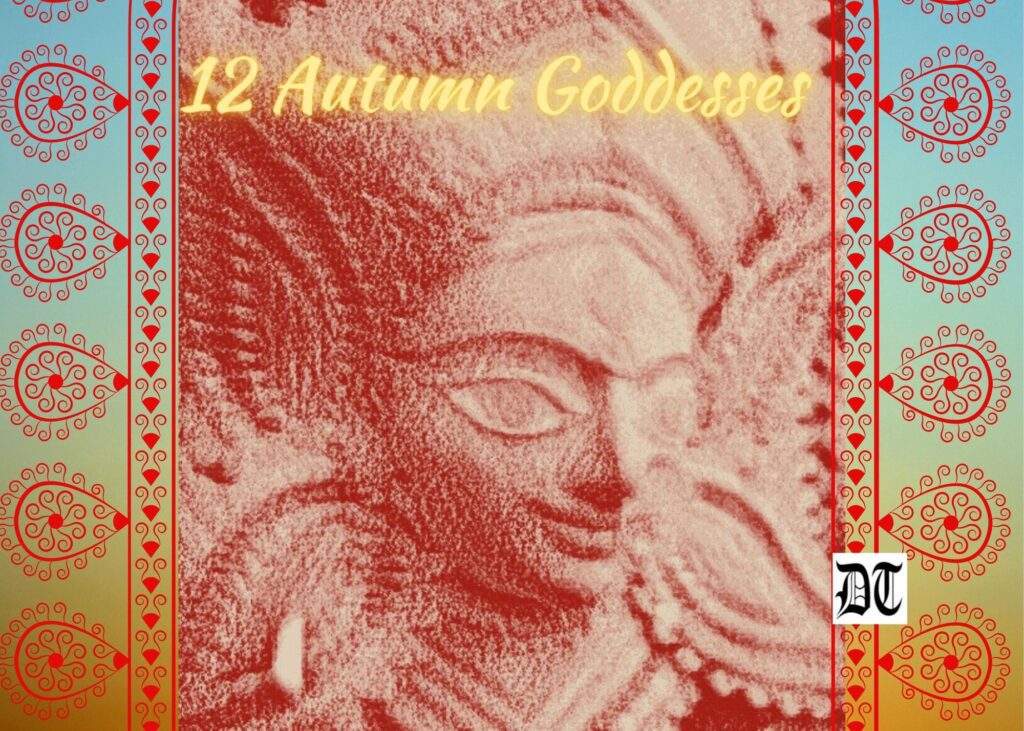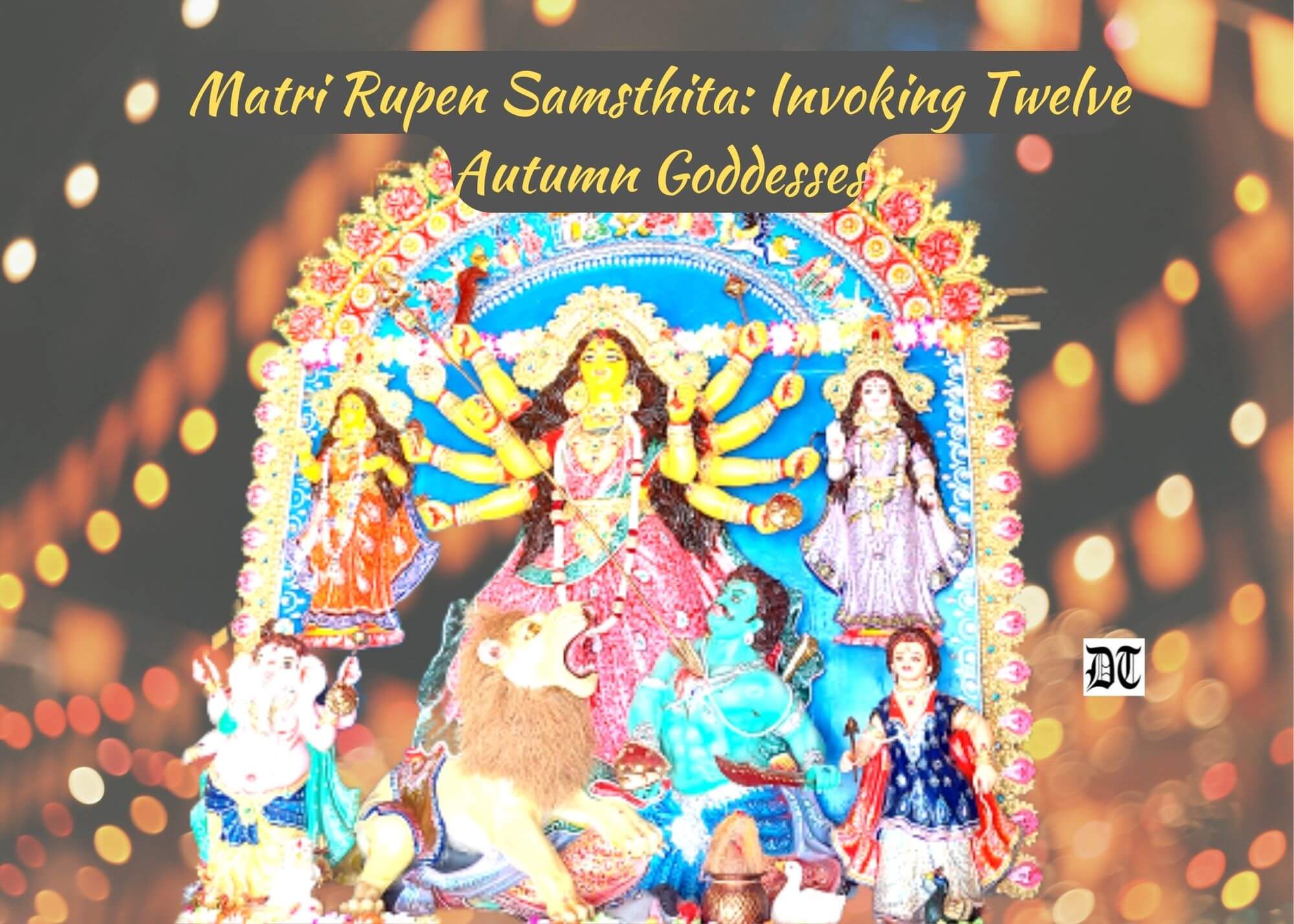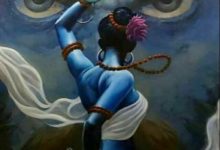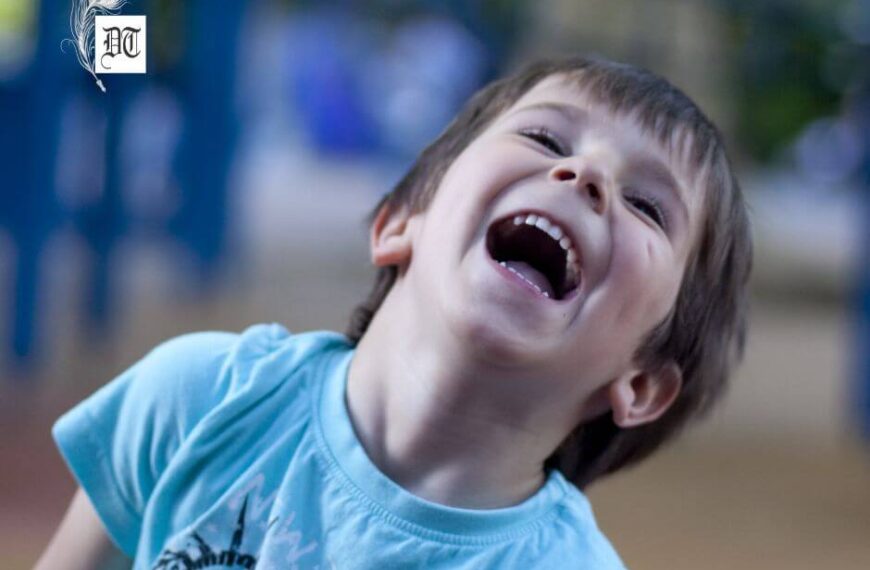
Our Founder and Editor-in-Chief, Arindam, traces the genesis of the mother worship from the Vedic, Upanishad, Puranic, the two epics and other religious texts. He discusses the Special Issue on 12 Autumn Goddesses – an exclusive Special Feature for Different Truths.
Hinduism worships the Divine as the Eternal Mother. Vedanta calls the formless, attribute-less ultimate Brahman Saguna Brahman or Ishvara when it takes form via Maya. God was Sri Ramakrishna’s ‘Mother’. The Mother-idea resulted from a new image of God as the Universal Force. Swami Vivekananda quotes a Vedic song to the Goddess: “I am the sun and moon’s brilliance; I am the breath that gives all things life.” Mother worship arises from this germ.
Hinduism dates to the Rig Veda hymns, which describe the evolution of human intellect. Worshipping demi-personified natural phenomena like fire, wind, and rain reveals the ultimate Spirit. Gods merged. Given their overlap, it was suggested that these deities must be the same. Aditi, referenced 80 times in the Rig Veda, finest exemplifies the Vedic Mother deity.
Her splendour and grandeur merit respect from her offspring, who are the gods. Vedic seers pray to heaven and earth as Father and Mother for protection from sin. Taittiriya Aranyaka’s ‘Durga Sukta’ is exquisite. Agni (male and female deity) is the fierce Goddess, Durga. She protects all creatures and cradles them tranquilly.
Later Puranic literature depicts Night as coming from Brahman’s Maya. In the Kena Upanishad, Uma Haimavati is Brahman’s power. According to Shankaracharya and Sayanacharya, Uma epitomises Vidya, or “spiritual knowledge.” It’s unclear if ceremonies and devotion rituals linked with the Divine Mother in her famed incarnations were practised throughout the Ramayana and Mahabharata epic times. Shakti combines empirical and theoretical elements.
Puranic cosmology empirically uses Shakti. Almost every Shiva temple portrays the god in linga-yoni, symbolising Shiva and Shakti’s everlasting unity. While trust in the Divine’s powers is universal, it takes on a different colour in India since this force is seen as its “female counterpart or companion.” In Puranas and Tantras, numerous Vedic and Upanishad goddesses became the Supreme Goddesses. Shakti is Chandi, Durga, Jagaddhatri, and Annapurna in Puranic literature.
Devi Bhagavata celebrates the Goddess’s many accomplishments. In the Chandi, the deity is called “Devi” but later “Durga.” Durga is also called Annapurna or Annada, the nourisher, and Jagaddhatri, the world supporter. She is the spring goddess Vasanti. The Devi has three forms, one for each guna (sattva, rajas, tamas).
Durga Saptashati exposes her individuality. Sati rushes into the sacrifice’s flames after being abused by her husband. Vishnu dismembers Sati with his discus. Shiva’s agony ends with the body’s removal. Bengalis typically depict Mother Durga as Mahishasur Mardini. Devi’s vehicle is a lion, and she’s accompanied by Lakshmi, Saraswati, Ganesha and Kartika.
Kali’s devotion is honoured on the new moon night following Durga Puja.
While discussing the theme of this Special Issue with my team, I realised that there weren’t just nine forms of Goddess Durga but quite a few more. On Sharad Purnima, we worship Kojaguri Lokhi (Lakshmi), the tenth form of Mother-worship. This is followed by the invocation of Goddess Kali (on Diwali) and Goddess Jagaddhatri, a day after Bhai-dooj in Bengal, thereby completing 12 manifestations.
We featured various aspects of the Autumn Goddesses for eleven days between September 26 and October 6.
Please see the days and dates below for relishing this Special Issue. Also, for mentions in the edit.
Rituparna Khan, a Kolkata-based writer and poet, struck the keynote of the theme in the Cover Story, Durgotsav Bridges Class & Ethnicities: Window to the World – Different Truths (Day Five: September 30).
Prof Nandini Sahu, a Mythology and Folklore scholar, pens a scholarly article, Folk Deities as the Alternative Myths in India – Different Truths. This is our Cover Story on Day Ten: October 5.
Azam Gill from France uncovers a unique aspect of Shastra worship that unites diverse places and cultures. Read our Cover Story, A Ritual for Weapons Unite Durga, Khalsa, Indo-Europeans – Different Truths (Day Seven: Oct 2).
Interestingly, we have two articles on Saraswati in this issue. One by Monika Ajay Kaul, an art historian (Day Three: September 28) and the other by Rupa Rao, from the US (Day Ten: October 5).
Tapti Sinha, an erudite and prolific writer, penned three stories, including a humour piece. She deserves special mention for tracing the antiquity of mother worship across many ancient civilisations. Also, genetically the long line of mothers passes on the power source in the DNA. It’s our Cover Story on Day Nine: October 4.
Our Dacca correspondent, Tabassum Tahmina Shagufta Hussain, drew our attention to the cultural aspect of Durga Puja across faith and religious beliefs. The Bangladesh government’s secular image gained strength with the slogan: “Belief is individual, festivities are universal.” See our Cover Story on Day Four: September 29.
Our Managing Editor, Anumita Roy, from Columbus, Ohio, the US, contributed three articles, including a humourous piece (Day Two: September 27). Her writing on Lakshmi puja merits special mention (Day Four: September 29).
Singapore-based Mitali Chakravarty (Publisher and Editor, Borderless Journal) has two articles in this Special Issue, including the Cover Story (Day Two: September 27).
Madhu Gangopadhyay deserves a special mention for her lyrical piece, our Cover Story (Day Eight: October 3)
Sarika Sarkar has contributed two First Leads to this issue: Day One: September 26 and Day Seven: October 2.
Several short story writers and poets have added literary value to the Special Issus on 12 Autumn Goddesses.
My sincere thanks to my teammates, who burnt the midnight oil to bring out this issue, sacrificing festivities. I am also grateful to all writers and scholars for enriching us.
Happy Reading!
Day One: September 26
In the Cover Story, Heralding the Advent of Goddess Durga: A Homecoming – Different Truths, Goddess Durga is worshipped as vegetation, soil, and human form. Tapti Sinha from Kolkata elucidates her nine forms, Navdurga and tells us about her homecoming.
In the lead article, Man Creates God in Kumortuli – Different Truths, Hyderabad-based Sarika Sarkar reminisces about Durga Puja in Assam, where she grew up. She recalls visiting Kumortuli, the potters’ colony inhabited by the idol makers for ages. They live in abject poverty in dark, narrow alleys, but this is a place where men create Gods.
In a humourous take on Ram Lila, Arindam Roy revisits the Ramdal and Ramlila and recalls the terrible faux pas that left Hanuman angry and cussing. He also recalls an incident that his friend, Vijay, told him about in Mumbai. His mother was superstitious about an actor playing the role of Rama in a Ramlila nearby. Find out what happened in his article, When Hanuman Cussed and Rama Smoked Bidi! – Different Truths
In the poem, Autumnal Inspiration! – Different Truths Anoucheka Gangabissoon invokes the goddesses of the Autumnal festivities, transcending from the mundane to the universal.
Day Two: September 27
In the Cover Story, The Homeless in the Festival of Homecoming – Different Truths, Goddess Durga’s homecoming, Mitali Chakravarty from Singapore, reminisces about the fragrance of three seasonal flowers and reminds her of home. She reflects on the homelessness of refugees – no homecoming for them.
The lead story, Durga’s Stature & Iconography Evolved in the Gupta Period – Different Truths by Arindam Roy, Editor-in-Chief, traces the history of Durga iconography. Historians at Allahabad Museum opine that the stature of the Goddess grew during the Gupta period.
Durga, an NRI, flies to her parents’ home, with her four children, in Kolkata, amidst the Covid-19 pandemic. Managing Editor, Anumita Roy, humanises Durga and her children, with sparkling wit and humour, in the short story Mishap Trip of Durga – Different Truths.
Deeya Bhattacharya, a feminist poet, invokes Durga, the Divine Mother, the fountainhead of Shakti (Energy), in an intense poem, Durga, the Matri Shakti – Different Truths.
Day Three: September 28
In the Cover Story, Saraswati, the Guru, Dispels Ignorance, Creates Balance & Unity – Different Truths; Saraswati is seen as Adi Shakti, symbolising the ultimate truth. She is considered the Guru, the knowledge giver, elucidates art historian and critic Monika Ajay Kaul.
With the advent of Durga Puja, Bengalis in Kolkata go berserk. The fever and frenzy of Puja grip the city. A month or two before the festival, Gariahat, Hatibagan, and New Market markets are choked with women. The local clubs start promoting the theme of the puja pandals. The shopping malls are inundated with discount offers on clothing and apparel. Here’s a report, The Fever and Frenzy of Puja Grips Kolkata with Renewed Vigour – Different Truths, by Souma Kanti Roy.
In the short story, Padmavati: A Hurricane of the Heaven – Different Truths, Subhajit Sanyal tells us that Padmavati tried to save her pet duck, Hari, from being sacrificed at the altar of the Goddess. No one could ever imagine challenging the oppressive village landlords, the Chatutis and their priests. But Padma committed blasphemy by stealing the sacrificial duck. What happened to her? Why did fear replace wrath and rage?
Durga, Kali, Saraswathi, Lakshmi and Parvathi… – Different Truths is a woman-centric protest poem by Parvathy Ramachandran.
Day Four: September 29
Our Bangladesh correspondent from Dacca, Tabassum Tahmina Shagufta Hussain, in the Cover Story, Durga Puja in Bangladesh: An Inseparable Cultural Legacy – Different Truths, shows us its secular face. She states that religion and faith are personal; festivities belong to all. It’s the Bangladesh government’s secular policy. Economic growth’s positive impact is palpable.
In the lead story, Goddess Lakshmi, Bless my Home! – Different Truths, Columbus, Ohio-based Anumita Roy takes a trip down memory lane and recalls the Lokhi (Lakshmi) puja at her Kolkata home. She tells us how the Goddess is a part of everyday discourse in Bengal. She transcends from the personal to the Universal, giving us an insight into her iconography and many forms.
Kiron Pishi – Different Truths is an excerpt from a forthcoming novel, Porridge and I: A Post-Colonial Story, concerning the fearsome Goddess Kali by Meerut-based poet and author Dr Roopali Sircar Gaur.
Which Durga should we worship? Asks a little girl. Delhi-based poet, author and editor Sutapa Basu pays tribute to the mortal Durga and the Goddess in the poem Ode to Devi Durga – Different Truths.
Day Five: September 30
Rituparna Khan, a Kolkata-based poet and writer, strikes the keynote of this year’s theme. She elucidates the 12 Autumn Goddesses invoked now in the Cover Story, Durgotsav Bridges Class & Ethnicities: Window to the World – Different Truths. Durgotsav represents the Mother Worship, an ancient legacy. UNESCO has awarded West Bengal Durga Puja the heritage tag, making it the first Asian festival with prestigious recognition.
The short story, How Little Adrija Battled an Evil Uncle! – Different Truths, by Mumbai-based poet and writer Sudeshna Mukherjee, makes you pause and think. Durga Puja brings joy and delight. Children and local artistes participate in plays, dance dramas and other cultural extravaganzas. Adrija, the protagonist, too was busy rehearsing a dance drama authored by Tagore. Amod Kaka’s (uncle) touches and lewd gaze disturb her. What does she do?
Eyes closed, each of us disappears into our consciousness where we perhaps see a beloved departed parent or remember a past when they stood above us uttering these same words after shoving a crumpled flower and a bael leaf into our small fists. Chennai-based Sumita Dutta gives us an overview of the Durga Puja and its nitty-gritty in Durga Puja: A Five-day Extravaganza of Food, Feast, Fun, and Frolic – Different Truths.
Rashmi Jain invokes Durga, the Adya Shakti (Primeval Mother), the supreme source of power and energy, to slay the demons of the present day. A poem on contemporary women’s issues for Durga puja, Durga, the Adya Shakti: An Invocation – Different Truths.
Day Six: October 1
In the Cover Story, Reflect, Refrain & Reform: Slay the Evil Within! – Different Truths, Mona Vijaykar, elucidates the symbolism of Navratri (Nine Nights), split into three parts, each of three nights. These represent Durga, Lakshmi, and Saraswati and the victory of Good over Evil.
Rajini Sankar, in Pan-India Navaratri Celebrations with Special Reference to South India – Different Truths, takes an overview of the Navaratri celebrations in Gujarat, Bengal, Tamil Nadu and Karnataka – a comparative study. It’s a predominantly women-dominated festival celebrating Shakti. Navratri is celebrated by observing fast, some all-night bhajans, etc., on a mock staircase called Goluppadi.
Here’s Tapati Sinha’s fictional Durga-Shiva dialogues, full of banter, repartee, wit, and humour. It creates a laughter riot in A Slice of Divine Life: Live from Kailash – Different Truths.
The four-day euphoria of Durga Puja is lost in the wink of an eye, and we go back to our robotic lives, says the poet, Sunanda Bhadra, in verse, Durga Puja for a Bong – Different Truths.
Day Seven: October 2
We digress from the theme on the birth anniversary of Mahatma Gandhi, Father of the Nation, who championed peace worldwide, by Dr Roopali Sircar Gaur. A poetic tribute in Peace and Liberty: The Salt of Life – Different Truths.
A war goddess, Durga, and warrior brotherhood, Sikh Khalsa Panth’s ritual veneration and reverence for weapons – where the Indo-European cultures, the divine unites with the profane – elucidates Azam Gill from France, in A Ritual for Weapons Unite Durga, Khalsa, Indo-Europeans – Different Truths.
Bhog, offering an elaborate lunch to the deities, is an integral part of the puja rituals. The menu is almost the same for all the Autumnal Goddesses. Sarika Sarkar shares a complete Bhog platter – savoury, sweet, delicious, and elaborate – in Blissful Bhog: Durga, Lakshmi, Kali & Jagadhatri Pujas – Different Truths.
As Puja comes closer, the plans for the outing get chalked out, and the list of Thakur Dekha (visiting the pavilions to see the idols) with friends and family is finalised every night. The new couple saves some time for their privacy. The stealing of glances continues during worship hours, says Shubhajit Sanyal, in Durga Puja is the Time for Teenage Crushes and Love – Different Truths.
In Goddess Kali Will Knock Your Door! – Different Truths Pankhuri Sinha pays obeisance to Goddess Kali, who emerged from Parvati, and worshipped on Diwali, reminding us of the humane and kind acts that she would enquire from us.
Day Eight: October 3
Madhu Gangopadhyay revisits the lore of her childhood – an integral part of her past – that still lingered. The Goddess of Bengal enjoyed non-veg while she was vegetarian in northern states celebrating Navratri. Why so? Find out more in the Cover Story, Durgotsav, Navratri & the Lore of the Yore! – Different Truths
In the article, Looking Forward, Looking Back: Durga Puja in my Eyes – Different Truths, Vedatrayee Dutta reminisces about Durga Puja and tells us what it means to her – an Autumn love affair with Kolkata.
Freshly returned from South America, first time Durga Puja to experience the vast unsettled feeling yet from being brought to a relatively stringent and conservative environment in Batanagar from the freedom of life in outside India, in Venezuela, rues Susmita Bhattacharya, as she walks down the memory lane in Durga Puja Nostalgia: Opening an Old Album and the Paroxysms of Emotions – Different Truths.
Harinder Cheema invokes nine avatars of Durga in reverence to the Mother Goddess in the poem Navratri: Nine Avatars of Ma Durga – Different Truths.
Day Nine: October 4
Mothers are the only source of mitochondrial DNA, which produces ATP, the energy currency of all biological systems. Genetically, the long line of mothers thus passes on the power source. Tapati Sinha, an erudite Kolkata-based scholar, elucidates that the human mother inspired mother-worship in ancient civilisations, including Adi Shakti, in the Cover Story, Shakti: Energy Currency of Biological Systems Powered by Mothers – Different Truths.
Every year during Durga Puja, several music albums are released. It’s a cultural legacy of the Bengalis worldwide. Ruchira Adhikari Ghosh reviews some of the 2022 music releases in the lead article, Durga Puja Music Albums: Bengalis’ Cultural Legacy Worldwide – Different Truths.
In the article, A Simple Durga Puja Far from the Maddening Crowd – Different Truths, far from the madding crowd and the razzmatazz of Kolkata, where Durga Puja, or any other puja, is more about pomp and show, the reporter Mallika’s sister visited Gorjangal, on the outskirts of Shantiniketan. Here’s a report.
The evocative poem, Joy of Giving – Different Truths, by Abu Siddik, is about the ambience during Durga Puja.
Day Ten: October 5
In the Cover Story, Folk Deities as the Alternative Myths in India – Different Truths, Prof. Nandini Sahu discusses myth as an alternative to folk deities; with her exclusive concentration on folk ethnicity, she delves into the partnership between folklore and religion with all its nuances and complexities. Religion is one of the significant substitutes through which we comprehend the surrounding world.
In the lead article, Durga Puja amongst Faith, Fallacy and Festivity – Different Truths, Arindam Roy dwells on the contradictions of mythology. He discusses various contradictory tales and mythical lore. Faith must be laced with reason; he opines – an exclusive Special Feature for Different Truths.
Goddess Saraswati is a patroness of knowledge and fine arts. Rupa tells us about Navratri celebrations in South India, where the nine manifested forms differ from that of North India. Saraswati, a form of Durga, states Rupa Rao, in Goddess Saraswati: Patroness of Knowledge & Fine Arts – Different Truths.
Mitali Chakravarty, in Durga Puja: Past and Present – Different Truths walks down memory lane to recapitulate the Durga Puja of her childhood. She unfolds mythology, history, cultural traditions, gender roles and poetry. Now, COVID-19 is the new Mahisasur, along with other evils.
Day Eleven: October 6
In the Closure of the issue and Editorial, our Founder and Editor-in-Chief, Arindam, tells us about 12 Autumn Goddesses, the worship of the Mother Goddess and more in Matri Rupen (mother worship).
In the lead article, May Maa Durga Bless us with More Shakti, not Power! – Different Truths, Ram Krishna clears the confusion between Shakti and power. While power is transient, short-term, meets limited purposes and is prone to misuse and abuse, Shakti, on the other hand, is an inner energy force, indefatigable and inexhaustible.
Spirituality empowers us, while religious dogmatism blinds us. Kabir Deb finds the former in Durga. She helps us become socially responsive, in
Madhu Gangopadhyay revisits the lore of her childhood – an integral part of her past – that still lingered. The Goddess of Bengal enjoyed non-veg while she was vegetarian in northern states celebrating Navratri. Why so? Find out more in the Cover Story, Durgotsav, Navratri & the Lore of the Yore! – Different Truths
In the article, Looking Forward, Looking Back: Durga Puja in my Eyes – Different Truths, Vedatrayee Dutta reminisces about Durga Puja and tells us what it means to her – an Autumn love affair with Kolkata.
Freshly returned from South America, first time Durga Puja to experience the vast unsettled feeling yet from being brought to a relatively stringent and conservative environment in Batanagar from the freedom of life in outside India, in Venezuela, rues Susmita Bhattacharya, as she walks down the memory lane in Durga Puja Nostalgia: Opening an Old Album and the Paroxysms of Emotions – Different Truths.
Harinder Cheema invokes nine avatars of Durga in reverence to the Mother Goddess in the poem Navratri: Nine Avatars of Ma Durga – Different Truths.
Day Nine: October 4
Mothers are the only source of mitochondrial DNA, which produces ATP, the energy currency of all biological systems. Genetically, the long line of mothers thus passes on the power source. Tapati Sinha, an erudite Kolkata-based scholar, elucidates that the human mother inspired mother-worship in ancient civilisations, including Adi Shakti, in the Cover Story, Shakti: Energy Currency of Biological Systems Powered by Mothers – Different Truths.
Every year during Durga Puja, several music albums are released. It’s a cultural legacy of the Bengalis worldwide. Ruchira Adhikari Ghosh reviews some of the 2022 music releases in the lead article, Durga Puja Music Albums: Bengalis’ Cultural Legacy Worldwide – Different Truths.
In the article, A Simple Durga Puja Far from the Maddening Crowd – Different Truths, far from the madding crowd and the razzmatazz of Kolkata, where Durga Puja, or any other puja, is more about pomp and show, the reporter Mallika’s sister visited Gorjangal, on the outskirts of Shantiniketan. Here’s a report.
The evocative poem, Joy of Giving – Different Truths, by Abu Siddik, is about the ambience during Durga Puja.
Day Ten: October 5
In the Cover Story, Folk Deities as the Alternative Myths in India – Different Truths, Prof. Nandini Sahu discusses myth as an alternative to folk deities; with her exclusive concentration on folk ethnicity, she delves into the partnership between folklore and religion with all its nuances and complexities. Religion is one of the significant substitutes through which we comprehend the surrounding world.
In the lead article, Durga Puja amongst Faith, Fallacy and Festivity – Different Truths, Arindam Roy dwells on the contradictions of mythology. He discusses various contradictory tales and mythical lore. Faith must be laced with reason; he opines – an exclusive Special Feature for Different Truths.
Goddess Saraswati is a patroness of knowledge and fine arts. Rupa tells us about Navratri celebrations in South India, where the nine manifested forms differ from that of North India. Saraswati, a form of Durga, states Rupa Rao, in Goddess Saraswati: Patroness of Knowledge & Fine Arts – Different Truths.
Mitali Chakravarty, in Durga Puja: Past and Present – Different Truths walks down memory lane to recapitulate the Durga Puja of her childhood. She unfolds mythology, history, cultural traditions, gender roles and poetry. Now, COVID-19 is the new Mahisasur, along with other evils.
Day Eleven: October 6
In the curtain raiser and Editorial, our Founder and Editor-in-Chief, Arindam Roy, tells us about 12 Autumn Goddesses, the worship of the Mother Goddess and more in Matri Rupen Samsthita, in The Genesis of Mother Worship: Invoking 12 Autumn Goddesses – Different Truths
In the lead article, May Maa Durga Bless us with More Shakti, not Power! – Different Truths, Ram Krishna Sinha clears the confusion between Shakti and power. While power is transient, short-term, meets limited purposes and is prone to misuse and abuse, Shakti, on the other hand, is an inner energy force, indefatigable and inexhaustible.
Spirituality empowers us, while religious dogmatism blinds us. Kabir Deb finds the former in Durga. She helps us become socially responsive, in Spiritual, not Religious… – Different Truths.
In the poem, The Supernova – Different Truths, Lopamudra Banerjee’s dedication to the icon of Goddess Durga, the creative feminine force that is at the core of our religious, cultural and mythological milieu, a poem that attempts to transcend the image and metaphor of Durga and represent her about ‘every woman’ of our times.
.
Picture design Anumita Roy, Different Truths






 By
By
 By
By
Tracing history of Maa Durga is enlightening. Thanks a lot.
Amazing vast choice of readings giving indepth glimpse into cultural uniqueness and explosion of colorful rituals. thank you for this treat!!!